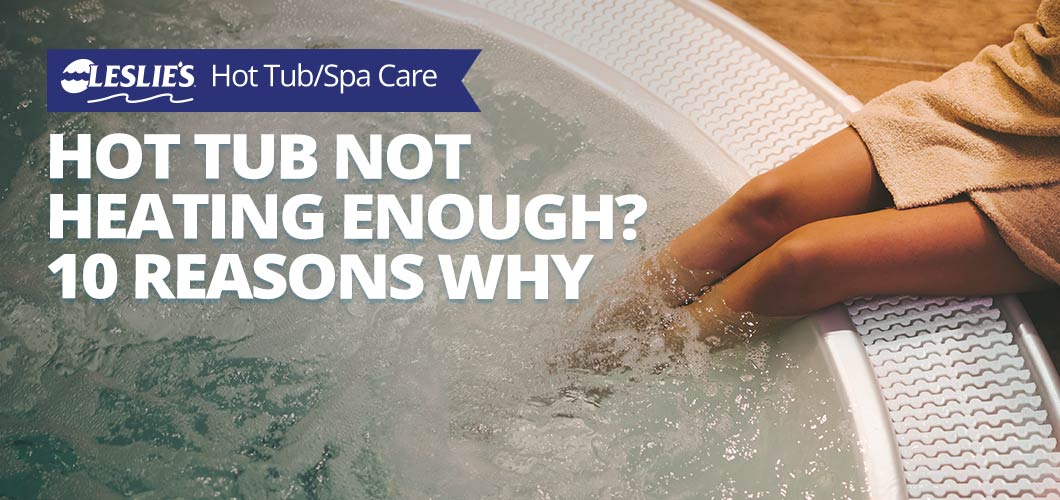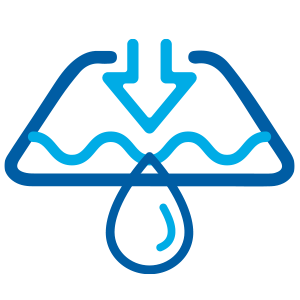
Hot Tub Not Heating Enough? 10 Reasons Why
Hot tubs should be…well, hot! If the water temperature for your hot tub is warm, and not quite as hot as you like, we’re here to help! If your hot tub isn't heating properly, there are a number of things that could be at play. Whether it's an inefficient, ill-fitting hot tub cover, a malfunctioning hot tub heater, power issues, faulty parts, or even poor insulation, it's important to identify the root of the problem. The experts at Leslie’s have the hot tub know-how and all the hot tub supplies you need to get back to the temperatures you desire.
The recommended maximum temperature for healthy adults is 104°F. If you are experiencing a lower temperature and you aren’t seeing any error codes on the hot tub display panel, here are 10 items to assess to help you identify and fix the problem(s) with your hot tub.
1. Hot Tub Heater Malfunctioning
Most hot tub heater elements have a lifespan of about 5–10 years. Check wires and connections to the heater, and ensure all connections are tight. Look for signs of frayed, chewed, or burned wires, and make sure there is power coming to the heater. If you notice the coating around the filament of the heating element has any cracks or chips, replace the element.
DIY TIP: Rule out power problems by testing for voltage coming into your spa pack. Then verify that the voltage is reaching your heating element. Sometimes a bad contactor can prevent voltage from reaching the element.
If you are comfortable testing voltage, you can check the volts on the heater terminals with a multi-meter or AC volt meter. Set the meter to AC volts, with a setting higher than 240V. With the thermostat turned up and the pump running on high, touch or clip each meter lead to each terminal (at the same time). You should see 220 volts or something pretty close (215–225V). If you get 220V but no heat, this usually means the heater element isn't working properly. If you don't get any volts while testing the heater leads or terminals, check that GFCI outlet or circuit breakers have not tripped. Make sure the thermostat is turned up. If you still get nothing, the circuit board is likely bad.
Another item to check is power continuity. With power off, place your multi-meter on the lowest Ohms setting. Then, touch each lead to each terminal at the same time. If the meter doesn't move, the element is bad. If the meter does move and shows steady resistance, the element is probably good, but there may be a short. Again, inspect the element for cracks or chips.
2. Hot Tub Cover is Inefficient

If it seems your spa or hot tub is not heating enough, the problem could actually be your cover. An economy spa cover isn't going to provide the same heat-trapping efficiency of thicker and denser spa covers. The R-value of the best hot tub covers can be three times the R-value of a basic economy level spa cover.
Secondly, as spa or hot tub covers age, they can start to take on water and sag in the middle. Covers can also begin to rip on the edges or along the fold. If you see steam seeping out of the sides of your spa cover, this can bring enough heat loss to reduce the overall temperature of your hot tub.
Don’t forget to keep the cover on the tub while it's heating. This aids in heating the hot tub. For increased heat trapping efficiency, consider using a floating spa blanket.
3. Thermostat is Not Calibrated
On older gas-fired spa heaters and old hot tubs with mechanical thermostats (without any digital panel display), the spa thermostat can be adjusted. These thermostats have a copper wire and capillary bulb used to sense the water temperature. On the end of the switch is a 1/8" hex head adjustment screw. Turn it 1/4 turn clockwise, and give it a few hours to see how high the temperature rises.
Test water temperature before using, and be careful not to increase the temperature above 104°F. Although some hot tubs have safety measures in place to prevent this, it is possible to do so on some hot tubs. Adjusting the set point too high can be dangerous or unhealthy for spa users. It's also possible the thermostat is defective — they don't normally just go out of adjustment by themselves.

4. Outside Temperature is Too Low
Some spas and hot tubs are just not able to heat up when the outside temperature is too low. This is especially true for 110V plug-in portable spas or those with little insulation, which simply can’t warm the water fast enough to overcome heat loss. This is also true for spas and hot tubs with small heater elements under 4 Kw or 4,000 watts. The fact is, less expensive spas will have more trouble keeping up with low outside temperatures.
Using a top quality spa cover, floating spa blanket, improving insulation underneath the spa shell, and even wrapping the outside of a wood hot tub can all help compensate for low outside temperatures. Also, fun fact: hot tub heaters can be upgraded and up-sized.
5. Using the Air Blower
Using a forced air blower or opening the air intake knobs will always cool the water, because the air temperature is often much colder than the water temperature. If this is causing problems during cooler weather, you may want to turn the blower off.

6. Spa Heater Not Running Long Enough
Spas and hot tubs heat slowly. Some heat up as little as 1ºF per hour, although most can do 2–4ºF per hour. If the timer is not set to run long enough each day, the heater can have trouble keeping up. This is especially true when outdoor temperatures are low.
If timing is an issue, run the circulation pump and heater continuously on high speed. Some heaters will not operate with the pump on low speed. It can take up to 24 hours to fully reheat your hot tub. This, of course, depends on starting water temperature, outside air temperature, spa cover efficiency, and, most importantly, the size of your spa heater.
7. Bad Sensors or Switches
Modern spas use electronic temperature sensors and high-limit switches to constantly check water temperature inside and outside of the spa heater. These are connected by wires to a plug-in on the hot tub's main control panel.
On digital spa packs, you will usually see an error code (Sn, Sn1, HL, Hot, OH) when a temp sensor causes the heater to shut off. But if the sensors aren't calibrated and are off by a few degrees, a temperature sensor or thermostat can shut off the heater, thinking the spa is hotter than it is. Occasional tripping of the high limit switch is a nuisance, but not uncommon. However, frequent tripping issues can indicate low flow, a malfunctioning heater element, or sometimes even a bad high limit switch.
When your spa filter, suction intakes, or return jets are clogged, blocked or obstructed, the pressure switch will stay closed and keep the heater from working. The same happens if your pump is on low speed, or if valves are closed. Many spa pressure switches are adjustable from 1-5 psi, and when the internal diaphragm fails, it requires replacement.

8. Filter is Dirty
Earlier in the article, we agreed to assume there are no error codes. However, a dirty spa filter usually produces an error code (FL, Flo, FL1) if the pressure switch is sensing low flow and keeping the heater off.
You can remove the spa filter (spa cartridge) to see if flow improves because of a dirty spa filter. In this case, you may need to hit the reset button on the heater element. Clean spa and hot tub filters every 3-4 months. Replace them every 12-24 months to keep the hot tub water flowing and filtering well.
DIY TIP: If your filter is clean and in good condition, try troubleshooting other reasons for low flow rate in your hot tub. If your circulation pump has a strainer basket, check to make sure it's clean. Obstructed suction inlets, clogged pipes, or clogged pump impellers can all cause flow problems, as can obstructed outlets, closed valves, closed jets, and air in the pump. If all else fails, low flow errors are sometimes the result of a faulty pressure switch (see #7 above).
9. Hot Tub Was Just Drained and Refilled
For hot tubs or spas recently drained and refilled, you may want to run the heater continuously for a day or two until the water gets hot again. Once heated, reset the time clock to run for 4–8 hours daily, or as much as it needs to maintain most of the heat.
Also, be sure the spa circulation pump is fully primed. It should not be air locked or drawing in air. Both conditions will cause a heater to overheat and shut off. If this happens, you may need to hit the heater element reset button.

10. Water Level is Low
Low water levels can cause your spa skimmer to draw in a steady stream of air in a vortex inside the skimmer. It may also gulp down air because of a stuck skimmer door or thermometer. When this happens, it causes the heater to overheat and shut down. If this happens, you may need to hit the heater element reset button so your hot tub can start heating again.
Add water regularly to your spa to keep the level from dropping too low and drawing air into the suction intakes.
There you have it! When you're having problems with cool hot tub or spa water, these 10 issues are likely the reason your hot tub may not be heating to the right temperature. If you're looking for more information about various issues with hot tub heaters, take a look at our quick-read blog post, "Top 5 Hot Tub Heater Problems."